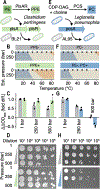Homeocurvature adaptation of phospholipids to pressure in deep-sea invertebrates
- PMID: 38935710
- PMCID: PMC11593575
- DOI: 10.1126/science.adm7607
Homeocurvature adaptation of phospholipids to pressure in deep-sea invertebrates
Abstract
Hydrostatic pressure increases with depth in the ocean, but little is known about the molecular bases of biological pressure tolerance. We describe a mode of pressure adaptation in comb jellies (ctenophores) that also constrains these animals' depth range. Structural analysis of deep-sea ctenophore lipids shows that they form a nonbilayer phase at pressures under which the phase is not typically stable. Lipidomics and all-atom simulations identified phospholipids with strong negative spontaneous curvature, including plasmalogens, as a hallmark of deep-adapted membranes that causes this phase behavior. Synthesis of plasmalogens enhanced pressure tolerance in Escherichia coli, whereas low-curvature lipids had the opposite effect. Imaging of ctenophore tissues indicated that the disintegration of deep-sea animals when decompressed could be driven by a phase transition in their phospholipid membranes.
Conflict of interest statement
Figures





References
-
- Somero GN, Adaptations to High Hydrostatic Pressure. Annu. Rev. Physiol 54, 557–577 (1992). - PubMed
-
- Cossins AR, Macdonald AG, The adaptation of biological membranes to temperature and pressure: Fish from the deep and cold. J. Bioenerg. Biomembr 21, 115–135 (1989). - PubMed
-
- Morein S, Andersson A-S, Rilfors L, Lindblom G, Wild-type Escherichia coli Cells Regulate the Membrane Lipid Composition in a “Window” between Gel and Non-lamellar Structures. J. Biol. Chem 271, 6801–6809 (1996). - PubMed

